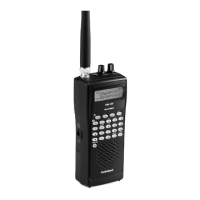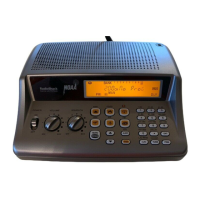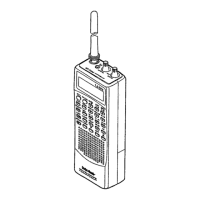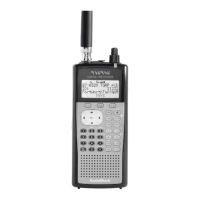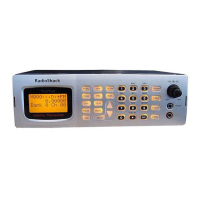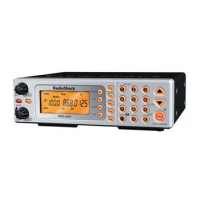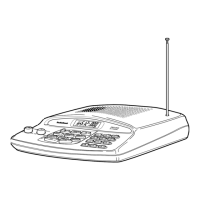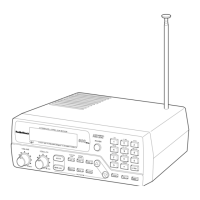Do you have a question about the Radio Shack PRO-29 and is the answer not in the manual?
Details the three available power sources for the scanner: internal batteries, AC power, and vehicle power.
Instructions for installing and replacing AA batteries, including recommendations for battery types.
Explanation of the scanner's POWER and CHARGE external power jacks and their functions.
Guidance on connecting the scanner to AC power using an optional adapter.
Instructions for powering the scanner using a vehicle's 12-volt battery.
Procedure for recharging nickel-cadmium batteries while they are inside the scanner.
Steps for attaching the supplied flexible antenna to the scanner.
How to connect earphones or headphones for private listening.
Guidance on connecting an external speaker for improved audio.
Instructions for attaching the belt clip for portability.
Explains the function and operation of each key on the scanner's keypad.
Details the various indicators and information shown on the scanner's display.
Describes how channels are organized into six banks of ten for easier identification.
Explains the use of six temporary memories for storing frequencies found during searches.
Initial steps for powering up the scanner and adjusting the squelch control.
Step-by-step guide on how to program frequencies into scanner channels.
Instructions on how to search for and temporarily store active frequencies.
Procedure for scanning frequencies within a specified upper and lower limit.
How to search for frequencies up or down from a currently displayed frequency.
How to access and listen to frequencies stored in monitor memories.
Procedure to transfer a frequency from a monitor memory to a permanent channel.
How to tune directly to a specific programmed channel.
How to activate and deactivate the keylock feature to prevent accidental entries.
Method to exclude specific channels from the scanning sequence.
Instructions for enabling or disabling specific banks for scanning.
How to program frequencies to be skipped during searches.
Setting a channel to be checked periodically for activity.
How to turn on the display's backlight for better visibility.
Procedure to access NOAA weather radio broadcasts.
Lists common frequency bands and their typical uses.
Identifies internal scanner signals that may cause interference.
Details typical band usage and associated frequencies for various services.
Lists common activities and their corresponding frequencies within VHF and UHF bands.
Explains the frequency step sizes used for different band types.
Lists typical services and their frequency ranges using abbreviations.
Method for identifying false signals caused by receiver intermediate frequencies.
Information on converting between frequency units (MHz, kHz) and wavelength.
Procedure to perform a full reset if the scanner's display locks up or malfunctions.
Details the three available power sources for the scanner: internal batteries, AC power, and vehicle power.
Instructions for installing and replacing AA batteries, including recommendations for battery types.
Explanation of the scanner's POWER and CHARGE external power jacks and their functions.
Guidance on connecting the scanner to AC power using an optional adapter.
Instructions for powering the scanner using a vehicle's 12-volt battery.
Procedure for recharging nickel-cadmium batteries while they are inside the scanner.
Steps for attaching the supplied flexible antenna to the scanner.
How to connect earphones or headphones for private listening.
Guidance on connecting an external speaker for improved audio.
Instructions for attaching the belt clip for portability.
Explains the function and operation of each key on the scanner's keypad.
Details the various indicators and information shown on the scanner's display.
Describes how channels are organized into six banks of ten for easier identification.
Explains the use of six temporary memories for storing frequencies found during searches.
Initial steps for powering up the scanner and adjusting the squelch control.
Step-by-step guide on how to program frequencies into scanner channels.
Instructions on how to search for and temporarily store active frequencies.
Procedure for scanning frequencies within a specified upper and lower limit.
How to search for frequencies up or down from a currently displayed frequency.
How to access and listen to frequencies stored in monitor memories.
Procedure to transfer a frequency from a monitor memory to a permanent channel.
How to tune directly to a specific programmed channel.
How to activate and deactivate the keylock feature to prevent accidental entries.
Method to exclude specific channels from the scanning sequence.
Instructions for enabling or disabling specific banks for scanning.
How to program frequencies to be skipped during searches.
Setting a channel to be checked periodically for activity.
How to turn on the display's backlight for better visibility.
Procedure to access NOAA weather radio broadcasts.
Lists common frequency bands and their typical uses.
Identifies internal scanner signals that may cause interference.
Details typical band usage and associated frequencies for various services.
Lists common activities and their corresponding frequencies within VHF and UHF bands.
Explains the frequency step sizes used for different band types.
Lists typical services and their frequency ranges using abbreviations.
Method for identifying false signals caused by receiver intermediate frequencies.
Information on converting between frequency units (MHz, kHz) and wavelength.
Procedure to perform a full reset if the scanner's display locks up or malfunctions.
| Brand | Radio Shack |
|---|---|
| Model | PRO-29 |
| Category | Scanner |
| Language | English |
